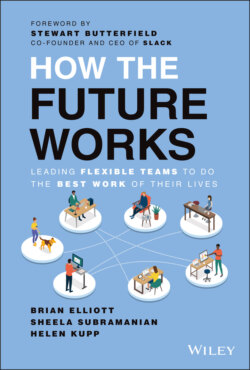Читать книгу How the Future Works - Brian Elliott - Страница 20
The What: Digital-First
ОглавлениеAs noted above, there are different versions of flexible work, and different companies have given different names to their flexible work strategies, as you'll see throughout this book. But there is a version of flexible work that we advocate based on our research and experience: Digital-First. It is the backbone of flexible work, and you need to adopt a Digital-First approach in order for flexible work to really work.
What do we mean by Digital-First? Let's start by defining what it isn't:
Digital-First is not the office-centric way of the past.
Digital-First is not just about location flexibility.
Digital-First is not a mandate about how many days a week people can work from home.
Digital-First does not mean never in person, or that all work gets done remotely.
Digital-First means making the switch from a mode of operations where digital technologies supplemented in-person communication as a way of getting work done, to one where in-person supplements the digital in order to build a more connected and inclusive way of working for everyone. This requires a switch in mindset. Companies can still have a headquarters, but it's going to primarily be a digital HQ, supplemented by physical office space. Companies can still build a connected and collaborative culture, but it's going to be built largely in digital forums, supplemented by in-person connections. And perhaps most importantly, Digital-First means embracing and prioritizing a truly flexible way of working, one in which people are given the freedom of choice—in terms of both when they work and where they work—in order to unlock their potential and enable them to perform at their best.
That desire for flexibility in when people work, as well as where, is one of the reasons we think terms like “hybrid” or “remote-first” aren't the right fit—they focus on location. To enable real flexibility, companies need to adopt a Digital-First mindset, recognizing that the only way to give people the schedule flexibility they need is to leverage digital tools that allow them freedom, not just in where they work, but when.
Moving to a Digital-First approach means putting as much thought and effort into the digital infrastructure that supports productivity and collaboration as we once did into our office buildings, desk configurations, conference rooms, and floor plans. Making this change is about more than just a switch in emphasis: Like anything else, if not executed well—if you don't get the how part right—you won't be successful.
